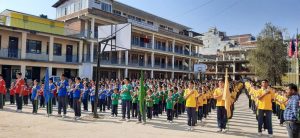
If the government plan is anything to go by, ninth and tenth-grade students of the schools across Nepal will have to study seven subjects only, one less than what the students have been studying for a past few decades, from the next year.
This is not news. What is news is that the government has proposed removing the compulsory Health, Population and Environment Education course for the two grades; and this has divided the stakeholders and experts.
The government and some educationists defend the proposal arguing eight subjects of 100 marks each would be too burdensome for the students and there were other important subjects which should not be missed. However, experts oppose the argument and claim that the subject is also equally important as maths and science, and it should have been given the continuity.
Bone of contention
The Ministry of Education recently finalised the National Curriculum Framework for the school level (Grade I-XII). The Curriculum Development Centre has already developed some courses under the new framework. Currently, it is being tested in various parts of the country.
The framework has proposed some key changes. For example, from grade 1 to 8, the students will learn a course on their mother tongue or local issues. Students of grades 11 and 12 have to study life skills education as a compulsory subject. The scope of Social Studies has also been extended to grade 12. Whereas these proposals have not sparked any apparent debate, the proposal to remove the compulsory course of health, population and environment education has virtually divided experts.
Padma Prasad Khatiwada, an associate professor at the Department of Population in Tribhuvan University, says the proposal to remove the course is an example of the shortsightedness of the government.

“We believe that Nepal’s population is currently in transition and it will continue for the next 20 years. Teaching the school students about population dynamics will be relevant till then,” he says. Khatiwada argues that students should understand contemporary society holistically. “Not only population, but other dimensions of the country are also in transition such as politics and economy,” he says, “These are the results of population transition and they cannot be understood without understanding the population transition.”
Khatiwada himself was involved in finalising an optional course on population studies for the grades. He says the government consults experts like him seeking feedback only after designing the courses and deciding which courses should be compulsory and which optional. It means the experts cannot change the model despite their interest to do so.
Likewise, public health expert Dr Aruna Uprety also decries the proposal as health education is an essential part of a person’s life; it matters not only in their childhood, but the entire life. “It should have been a compulsory subject through the entire school years and it should be taught well. Removing it from the course is stupid,” she says, “It will have an adverse impact on the country’s education sector in the long term.”
Reduction of burden
But the government officials have different logics. Lekha Nath Poudel, Director General at the Curriculum Development Centre, informs that the National Curriculum Development and Evaluation Council headed by the education minister floated the proposal after consulting stakeholders and experts.
“We decided to reduce the number of courses after calculating the required credit hours and available working hours. Then, we prioritised the courses; we agreed that Nepali, English, maths, science and social studies could not be removed. So we removed the last priority,” he clarifies. Poudel, however, refuses to answer why the council did not reduce the number of optional subjects from two to one or zero if the eight courses had been really burdensome.

Prominent educationist Bidya Nath Koirala views that the proposal to lessen the burden is welcoming provided all necessary contents of those subjects are taught in other subjects effectively.
“The more the subjects, the more likely it is that the students fail to acquire knowledge in depth. Internationally, the number of courses is low, but everything a child needs is taught practically,” he says, “Is environment a subject to teach in books or something that we do in our real life? Is population studies about teaching coursebooks or letting students assess the changes in population and their impact over time?”
Koirala doubts that the health, population and environment education might have been introduced as a compulsory subject in the school system a few decades ago due to the influence of I/NGOs and UN agencies.
Implications and impacts
The government side is not arguing that the relevance of the issues has been over. “The interested students can choose optional subjects,” the CDC’s information officer Ganesh Prasad Bhattarai informs, “The previous compulsory subject was a hotchpotch of three subjects. Now, as elective ones, they are specific and rich.”
Environmentalist Rajan Thapa agrees with Bhattarai and hopes that now onwards, the students can ‘specifically’ study environment science from the school level. “Earlier, you would be taught about climate change in bachelor’s or master’s classes only. Now, the content has been available for a ninth-grader also. It shows that the government is serious about global issues like climate change and global warming,” he says.
However, Thapa doubts if the government can provide sufficient skilled teachers to teach the course. “We need the people who have done bachelor’s or master’s in science to teach this content,” Thapa, who was also involved in designing the curriculum, says, “Otherwise, we will not achieve the objectives.”

Likewise, Khumananda Subedi, Executive Director of Skill Information Society Nepal that has been advocating for the inclusion of comprehensive sexuality education in the school curriculum, predicts the government’s plan to ‘specialise’ the subjects will fail because of the unavailability of teachers. “In the past, the government did not appoint sufficient teachers to teach health education. However, because that was a compulsory course, someone would at least teach that.”
“Now, the schools will stop teaching health, population or environment, pretending there aren’t any teachers,” Subedi says. According to him, when the government introduced the optional health course to pilot at schools across the Kathmandu Valley this year, only 14 schools chose to teach it.
“It tells you what will happen tomorrow,” hopeless Subedi comments.























